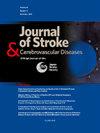Determinants of post-stroke cognitive impairment in patients with periodontal disease
IF 1.8
4区 医学
Q3 NEUROSCIENCES
Journal of Stroke & Cerebrovascular Diseases
Pub Date : 2025-04-22
DOI:10.1016/j.jstrokecerebrovasdis.2025.108327
引用次数: 0
Abstract
Introduction
Periodontal disease (PD) is a risk factor for stroke and cardiovascular disease. The effect of PD on post-stroke cognitive impairment (PSCI) remains underexplored.
Methods
A cross-sectional analysis of the Periodontal tReatment to Eliminate Minority InEquality and Rural disparities in Stroke (PREMIERS) study participants was conducted. Baseline cognitive function was assessed using the Montreal Cognitive Assessment (MoCA) within 90 days of the index event. MoCA score ≤21 indicated severe PSCI. White matter hyperintensity, indicating cerebral small vessel disease (cSVD), was evaluated using the Fazekas scale on MRI. Due to non-normal MoCA distribution, two analytical approaches were employed: 1) logistic regression using dichotomized MoCA scores based on clinically relevant cutoffs and 2) generalized linear mixed modeling after bootstrap normalization that examined MoCA scores continuously.
Results
Among 280 participants with PD, 48% exhibited severe PSCI. Both analytical approaches demonstrated that severe PD, African American (AA) race, and greater stroke severity significantly and independently predicted severe PSCI, while advanced education was protective. Fazekas' scale showed no significant associations with PSCI.
Conclusions
This study identifies PD severity as a novel and independent contributor to early PSCI. Traditional predictors like AA race, educational attainment, and stroke severity remained significant.
Clinical Trial Registration Information
https://www.clinicaltrials.gov; Unique identifier: NCT 02541032
牙周病患者脑卒中后认知障碍的决定因素
牙周病(PD)是中风和心血管疾病的危险因素。PD对脑卒中后认知障碍(PSCI)的影响仍未得到充分研究。方法对卒中患者牙周治疗消除少数民族不平等和农村差异(PREMIERS)研究参与者进行横断面分析。基线认知功能在指数事件后90天内使用蒙特利尔认知评估(MoCA)进行评估。MoCA评分≤21分为重度PSCI。MRI上采用Fazekas评分法对提示脑血管病(cSVD)的白质高信号进行评估。由于MoCA的非正态分布,我们采用了两种分析方法:1)基于临床相关截止点的二分类MoCA评分的逻辑回归;2)自举归一化后的广义线性混合建模,连续检测MoCA评分。结果280例PD患者中,48%表现为重度PSCI。两种分析方法均表明,严重PD、非裔美国人(AA)种族和更严重的脑卒中严重程度显著且独立地预测严重PSCI,而高等教育具有保护作用。Fazekas量表与PSCI无显著相关性。本研究确定PD严重程度是早期PSCI的一个新的独立因素。传统的预测因素如AA种族、受教育程度和中风严重程度仍然很重要。临床试验注册信息https://www.clinicaltrials.gov;唯一标识符:NCT 02541032
本文章由计算机程序翻译,如有差异,请以英文原文为准。
求助全文
约1分钟内获得全文
求助全文
来源期刊

Journal of Stroke & Cerebrovascular Diseases
Medicine-Surgery
CiteScore
5.00
自引率
4.00%
发文量
583
审稿时长
62 days
期刊介绍:
The Journal of Stroke & Cerebrovascular Diseases publishes original papers on basic and clinical science related to the fields of stroke and cerebrovascular diseases. The Journal also features review articles, controversies, methods and technical notes, selected case reports and other original articles of special nature. Its editorial mission is to focus on prevention and repair of cerebrovascular disease. Clinical papers emphasize medical and surgical aspects of stroke, clinical trials and design, epidemiology, stroke care delivery systems and outcomes, imaging sciences and rehabilitation of stroke. The Journal will be of special interest to specialists involved in caring for patients with cerebrovascular disease, including neurologists, neurosurgeons and cardiologists.
 求助内容:
求助内容: 应助结果提醒方式:
应助结果提醒方式:


